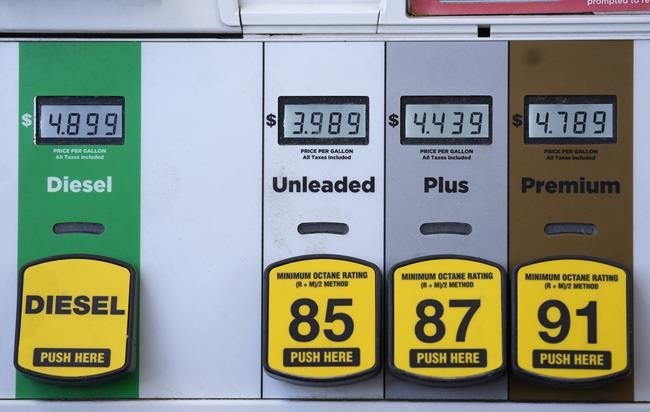WASHINGTON (AP) — An inflation gauge closely tracked by the Federal Reserve surged 6.6% in March compared with a year ago, the highest 12-month jump in four decades and further evidence that spiking prices are pressuring household budgets and the health of the economy.
Yet there were signs in Friday’s report from the Commerce Department that inflation might be slowing from its galloping pace and perhaps nearing a peak, at least for now.
And despite soaring prices, consumer spending rose faster than inflation for a third consecutive month, suggesting that rising prices haven’t cooled the desire of Americans to shop. The pandemic’s distortions to the economy are also fading as consumers shift their spending back to experiences like travel, concerts and dining out. That follows a two-year surge of pandemic spending on goods, things like exercise bikes, patio furniture and standing desks.
The switch to services helps restrain inflation because prices are rising more slowly for services than for goods.
Excluding the especially volatile food and energy categories, so-called core prices rose 5.2% in March from a year earlier. That was slightly below the 5.3% year-over-year increase in February, and it was the first time that 12-month figure has declined since February 2021, before the inflation spike began. And on a month-to-month basis, core prices rose 0.3% from February to March, the same as from January to February. Previously, it had risen by a half-point for four straight months.
“The slowdown in (core inflation) is really nice to see,” said Bill Adams, chief economist for Comerica Bank, in an email to clients. “Inflation may have peaked in March, although the evidence is still a little ambiguous. But inflation’s momentum is still very strong.”
Overall inflation jumped 0.9% in March from February, the biggest one month gain since 2005. Gas prices soared 18% just in March. But they have since fallen a bit this month, another sign inflation may start to slowly decline.
Consumers increased their spending by 1.1% last month, more than many economists had expected. The gain largely reflected higher prices at the gas pump, grocery store and other places where Americans shop for necessities. But even adjusted for inflation, spending rose 0.2%.
Sharp gains in wages and salaries are helping many consumers handle higher costs. A separate report Friday from the Labor Department showed that employees’ pay and benefits jumped 1.4% in the first three months of the year, before adjusting for inflation. That was the highest such increase on records dating back two decades.
Yet the gain isn’t big enough to completely offset higher prices. In the past year, wages and benefits have jumped 4.7%. But after adjusting for inflation, they are down 3.7%.
That decline helps explain why Americans are taking an increasingly negative view of the economy. About one-third of respondents to a Gallup poll, released Thursday, cited inflation as the most important financial problem their family faces today, up from fewer than one in 10 who said so a year ago.
Consumers are maintaining their spending by digging into the extra savings they built up during the pandemic. The saving rate fell to 6.2% in March, the lowest level since 2013.
A smaller savings pool may eventually restrain consumers, but that’s unlikely anytime soon.
Americans have about $2.1 trillion more in savings than they did before COVID, with some of that cash in lower-income Americans’ bank accounts. Economists at Bank of America note that, according to the bank’s data on checking and savings accounts, households that earn under $50,000 a year had an average of about $3,000 in their accounts in February — roughly double the pre-pandemic level.
High inflation and strong wage increases are leading the Federal Reserve to plan a series of sharp interest rates hikes in the coming months. The Fed is set to raise its benchmark short-term rate by a half-point next week, a faster move than its typical quarter-point hike and the first increase that large since 2000.
Outside the United States, too, inflation is surging, forcing other central banks to either raise interest rates or move closer to doing so. In the 19 countries that use the euro, inflation reached a record high of 7.5% in April from a year ago.
In Europe, spiking energy prices stemming from Russia’s invasion of Ukraine are playing a bigger role in driving inflation. The European Central Bank could raise rates for the first time since the pandemic in July, even as growth in the region has slowed because of the war.
The gloom that has gripped public opinion as inflation has accelerated is posing a growing political threat to President Joe Biden and Democrats running for Congress. Biden has pointed to a strong job market and solid consumer spending as evidence that his policies have helped Americans. But that view absorbed a setback Thursday, when the government reported that the economy actually contracted in the first three months of this year at a 1.4% annual rate.
How consumers respond to inflated prices — and much higher interest rates from the Federal Reserve — is one of the unknowns facing the economy this year. Moody’s Analytics estimates that the average household is spending $327 more each month to buy the same things they bought a year ago.
Christopher Rugaber, The Associated Press




